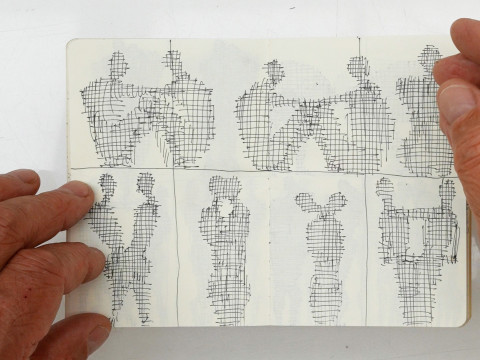
How to read it: Flaxman's 'The Iliad' and 'The Odyssey'
By Annette Wickham
Published on 11 August 2020
The 18th-century British artist John Flaxman was an established sculptor, but it was his drawn illustrations of 'The Iliad' and 'The Odyssey' that made him a sensation across Europe.
An earlier version of this article was published in September 2019.
Never heard of Flaxman? Well, in 18th-century Europe that was quite a different story
John Flaxman was once famous throughout Europe for his striking outline drawings of scenes from classical literature. Originally known as a sculptor, Flaxman produced the drawings on the side of his main career. When they were published as engravings at the end of the 18th century however, they were an instant hit.
Using only outlines, the illustrations appeared strikingly original and distinctive. Although many artists had depicted scenes from Homer’s epics and some illustrators used the outline technique, Flaxman’s combination of the two was innovative. Flaxman relied on ‘pure’ line with no colour, shading or tone. The results were rhythmic, economical yet elegant and were described as poetry in visual form.

Flaxman used his flair for design and knowledge of ancient art to produce compositions that convey complex stories in just a few lines. He was inspired by art forms like Ancient Greek vase painting and ancient relief sculpture, especially from tombs. The painter George Romney described Flaxman’s compositions as "simple, grand and pure" adding "they look as if they had been made in the age when Homer wrote". This apparent authenticity was a large part of their appeal.
Flaxman was a bit of a classical superfan
Flaxman was born in York in 1755 but grew up in London. He became one of the first students to enrol at the Royal Academy Schools in 1769 and went on to exhibit portrait busts and scenes from classical mythology. His work caught the eye of Thomas Wedgwood who commissioned Flaxman to produce designs for his fashionable ceramics. Despite early successes, Flaxman felt that his practice as a sculptor would benefit from further study of classical art. In 1787, he and his wife Ann Denman (also known as Nancy) set out for Rome where they stayed for seven years.

An inspired commission or a favour for a friend?
The original drawings in the RA Collection were commissioned by Georgiana Hare-Naylor, a friend of Flaxman’s, while they were both living in Rome. Hare-Naylor (née Shipley) asked Flaxman to illustrate Homer's The Iliad and The Odyssey with the intention of having the drawings engraved and published.
Hare-Naylor was described by a contemporary as "tall, handsome and self-sufficient, a painter and a scholar". She and Flaxman shared an interest in the classical world and spent evenings reading the epics of Homer aloud. The Hare-Naylors paid Flaxman between 15 and 21 shillings for each drawing, probably with the intention of helping the Flaxmans prolong their stay in Italy.
His skills were much in demand
Around the same time, Flaxman was also asked to illustrate Dante’s Divine Comedy by the art collector and banker, Thomas Hope. He produced a second set of the Homer drawings for another collector, Robert Fullerton Udney, and went on to create similar outline illustrations to the works of Aeschylus and Hesiod. These remained popular and later editions of these illustrations were published throughout the 19th century.

Flaxman's drawings caused quite a stir
Flaxman’s illustrations proved highly influential on following generations of artists throughout Europe. His outline technique, compositions and subject matter were appreciated not only by devotees of Neoclassicism like Jacques-Louis David and Jean-Auguste-Dominique Ingres, but also by Romantic artists like Francisco de Goya, William Blake and Phillip Otto Runge.
Just as the words of the poet are formulae for life and beauty…so it appears to be true wizardry how in a successful outline, so much soul can dwell in a few delicate lines...
A.W. von Schlegel on Flaxman’s outline illustrations, 1799
Flaxman himself seems to have been slightly taken aback by the response. He wrote to a friend in the autumn of 1793, "my view does not terminate in giving a few outlines to the world". He explained that he intended the drawings to show "how any story may be represented in a series of compositions on principles of the Ancients". Ultimately, he regarded the drawings as preparatory works since he hoped to translate many of the scenes into sculptural form.

The father of the modern comic?
Describing Flaxman’s outline drawings as ‘illustrations’ is slightly misleading. The engravings of the scenes were published as a series of plates accompanied only by a couple of lines each from Alexander Pope’s verse translations of Homer. They were intended to convey the story on their own rather through images rather than as visual accompaniments to a text.
In addition to providing inspiration for painters and sculptors, Flaxman’s outlines can be connected with the development of graphic novels during the 19th century. The first ‘picture novels’ were published in Europe in the 1830s by artists who had grown up looking at Flaxman’s ‘outlines’. Using a similar approach, they relied on a sequence of images to tell a story and paved the way for 20th-century comic strips. In fact, depictions of Marvel superheroes in action, especially in flight, can be compared to some of Flaxman’s designs, in particular the figure of Lucifer in his illustrations to Dante’s Inferno.

You can see Flaxman's original drawings for Homer's The Iliad and The Odyssey in the free display Storylines, in our Collection Gallery until 5 January 2020.
In 60 Seconds: Flaxman's 'Iliad' and 'Odyssey'
Learn about John Flaxman RA, and how his work inspired the first graphic novels. The 18th-century British artist was an established sculptor, but it was his drawn illustrations of The Iliad and The Odyssey that made him a sensation across Europe.
Related articles

Video: drawing penguins at London Zoo
3 February 2025

My sketchbook: sculpture drawings by Antony Gormley RA
13 January 2025

Video: Merry Christmas from the Burlington House choir
18 December 2024